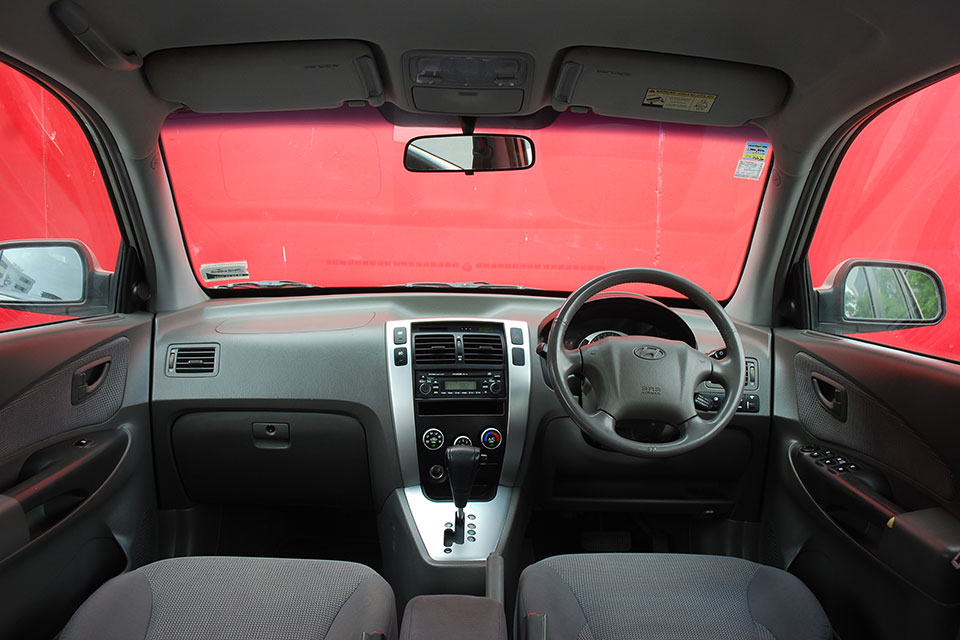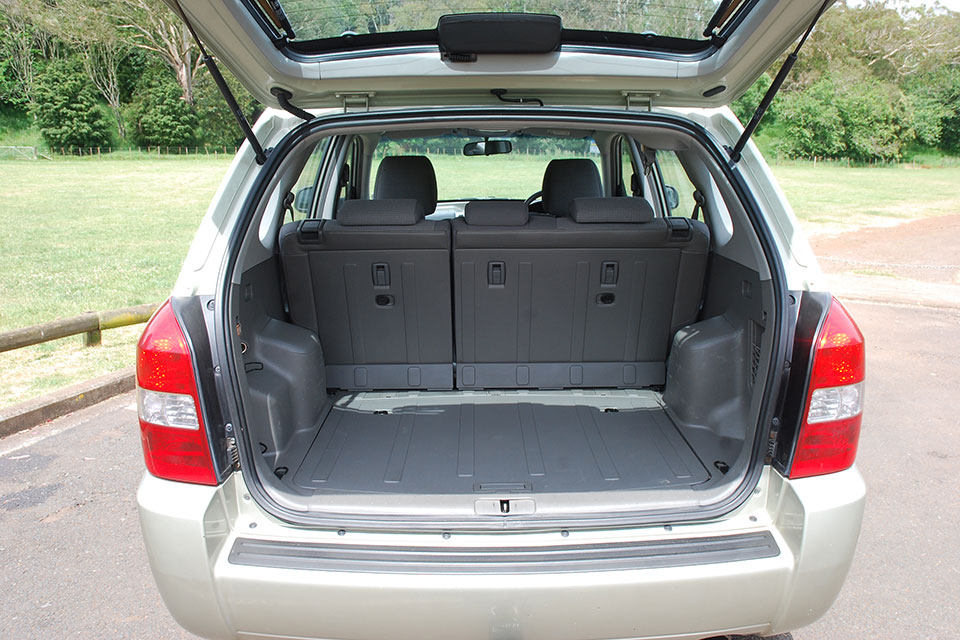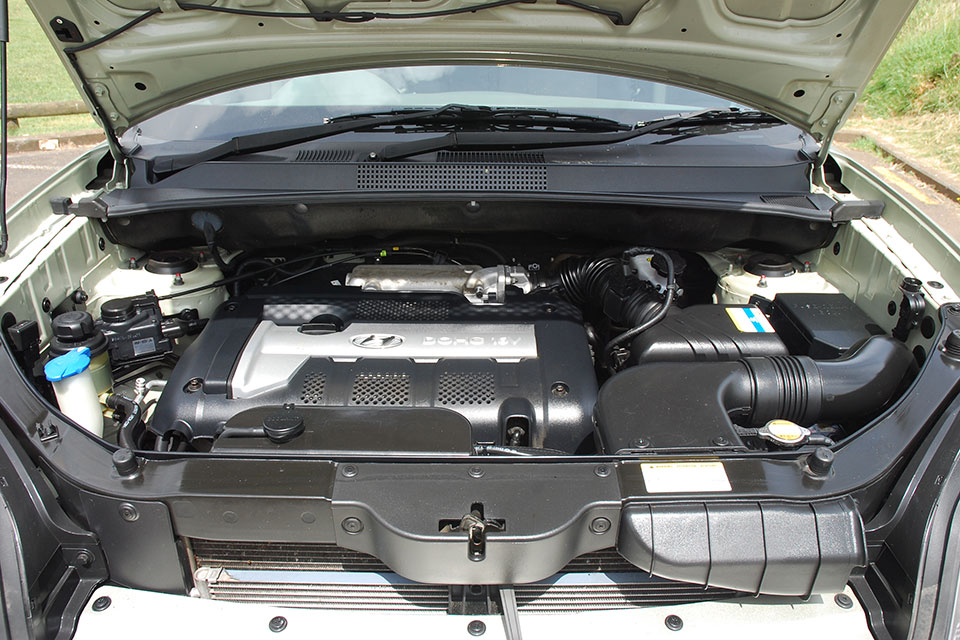Hyundai Tucson 2004-2009 used car review
The Hyundai Tucson is a small and durable city-focussed SUV.

The Hyundai Tucson is a small and durable city-focussed SUV. It is very good value and has lots of features at a low price.
The Tucson was the second Hyundai SUV sold in New Zealand after the larger Santa Fe. It’s based on the Elantra small sedan and liftback. It's also very similar mechanically to the Kia Sportage. Early models feature plastic body cladding and standard all-wheel drive, with a front-wheel drive “City” model launched soon after.
Inside and out
The Tucson looks tough and rugged for a small SUV. Alloy wheels are standard; both front and rear bumpers are large and chunky with a design that makes it look like they have protection plates underneath. The sides feature chunky plastic body protection although this is body coloured on most and is likely to be as easily damaged as they are metal panels. Roof rails are standard if you want to attach crossbars for carrying a bike or outdoor sports gear.
The Tucson feels more spacious inside than it looks from the outside. The dash is made of hard plastic and sweeps around into the top of the doors. The gauge cluster focuses on a large central speedometer. The centre console houses a basic CD player stereo and dial controls for the manual air-conditioning. Below it, the transmission shifter sits on a lower console within easy reach. The GLS gets a slightly dull grey interior colour scheme and the Elite is available in a sharper black style.
The front seats are not very supportive, with a short flat base and little side or lumbar support from the backrest. The driver’s seat base can be manually adjusted for angle. Rear seat passengers enjoy good head and legroom. Rear seat width is reasonable though it’s possibly not enough for three full-size adults to be comfortable for long.
The size of the boot is very impressive. There is no load lip and we think four large cases should fit. The floor and rear seat backs are covered in a hard plastic that can be easily wiped clean. It means you could fold down the rear seat and carry a dirty mountain bike. The surface is a little slippery but there are handy tie-down points to secure items to. The rear window glass can be opened separately if you only need to pop a small item in the boot.
On the road
Three engines are available in the Tucson. Initial options were a 2-litre four-cylinder petrol engine and a 2.7-litre six-cylinder petrol. A 2-litre turbocharged four-cylinder diesel was added later. A five-speed manual was available although most cars are fitted with a four-speed automatic which can be shifted manually. A six-speed manual was available with the diesel. All-wheel drive was initially standard but soon after launch a front-wheel drive model, called the City, became an option.
Our review vehicle uses the 2-litre four-cylinder engine, which produces 104kW and 184Nm. Although the engine is smooth, its performance isn’t great - acceleration is a little slow and you will need decent space to overtake on the open road. The four-speed automatic is smart around when it shifts, though it is not particularly smooth and you can clearly tell when it changes.
The ride is very comfortable though the trade-off for this is a little body roll when you go around corners. The steering is quick and very light, which makes the Tucson manoeuvrable and easy to drive in the city. Engine and road noise levels are quite low, however, we noticed the power steering pump was quite loud when turning tightly at low speeds.
Despite the Tucson’s SUV looks, it is best in the city. The all-wheel drive system can be locked to split torque between the front and rear wheels equally for extra-slippery conditions. It will handle a lightly rutted gravel track or paddock. We have also tried the Tucson on sand and it performed well. Serious off-road conditions will quickly show up its lack of ground clearance and road-orientated tyres.
The Tucson has an average tow rating for its size. It can pull 750kg unbraked (a medium-size garden trailer) and 1,500kg braked (a small to medium-size trailer boat).
Safety
The Tucson has an average safety in the SUV class - four-star under the ANCAP system and a three-star Used Car Safety Rating which is based on real-world crash data. Our 2007 model has a high level of safety features including front, side and curtain airbags, anti-lock brakes and electronic stability control. Models built before 2006 don’t feature electronic stability control or curtain airbags as standard.
There are no ISOFIX child seat mounts in the second row though there are three child seat tether points in the boot. The centre seat gets a full shoulder-type seat belt, which offers more protection than the lap-only type.
Reliability
The Tucson has a reasonable reputation for reliability, with serious mechanical issues uncommon. Electrical issues do appear to be more common as the model ages. The engine uses a cambelt which will require regular replacement.
The automatic transmission is not known to be particularly smooth. You should still check for thumping or jerking during gear shifts because it has been known to fail in rare cases. Due to the format of the all-wheel drive system, replacement is expensive.
The plastics are known to harden and become fragile over time. Check the electric window switches and indicator stalks particularly.
There have also been issues with the airbag system wiring. If an airbag light stays on when the vehicle is running, avoid the car - this indicates degradation in the wiring, which requires expensive, specialist repair.
The Tucson is well protected against rust but the paint quality does have some issues. Look for fade, clear-coat peeling and bubbles, particularly on the top of the vehicle.
Cost of ownership
Hyundai recommends servicing the Tucson every 12 months. Each service will cost around $350, with the exception of the 90,000km or six-year service. That service includes replacement of the cambelt and water pump and will cost $950.
The Tucson is a little thirsty compared to the competition. RightCar says the GLS will cost $2,770 a year to fuel over 14,000km, nearly $100 more than the slightly larger Toyota RAV4. The 58-litres fuel tank will cost $116 to fill at $2 per litre and should take you 530km before the fuel light comes on.
A vehicle licence for the Tucson costs $148.95 a year, with the car in the most expensive ACC levy group.
Trade Me Insurance estimates insurance for a Tucson valued at $11,200 will cost $49.23* per month. That’s more than $2 more expensive a month than a Kia Sportage.
Buyer's guide
This generation Tucson is available on Trade Me priced from $4,500 to $15,000. Mileage is a key factor in price: the cheapest cars have generally travelled more than 200,000km or more. A small number of Japanese import versions, called the JM, are on the market. These are basically the same as the GLS specification.
The Tucson should be seriously considered by shoppers looking at Japanese import SUVs of the same age. The Japanese cars might offer more performance but the Tucson trumps most of them on airbag count and safety technology - particularly important if the vehicle is for a family.
variants
- City - Features alloy wheels, fabric upholstery, leather steering wheel, manual air-conditioning, CD player stereo, roof rails and remote central locking.
- GLS - Adds all-wheel drive system, automatic headlights, fog lights and cruise control. From 2008 receives climate control.
- CRDi - As per GLS, though powered by a 2-litre turbocharged Diesel engine.
- Elite - Available as stand-alone model or in City or CRDi versions. Adds full leather interior, tinted windows, climate control air-conditioning and chrome trim.
Timeline
- 2004 Launched in New Zealand
- 2005 “City” front-wheel drive model and “CRDi” diesel added
- 2005 Safety specifications increased
- 2008 GLS receives climate control
- 2009 Replaced by new “ix35” model
Details
2007 Hyundai Tucson GLS
$8,000 to $16,000 for models which have travelled 70,000 to 120,000km
2-litre four-cylinder, 104kW and 184Nm
Four-speed automatic, all-wheel drive
Three-star Used Car Safety Rating
15,000km or 12 months
Full size tyre
9.9-litres per 100km (claimed)
Regular
4325mm
1800mm
1680mm
750kg (unbraked), 1500kg (braked)
10m
This review covers the Hyundai Tucson for model years 2004, 2005, 2006, 2007, 2008 and 2009.
Review vehicle supplied by Westwyn Trading.
*Our insurance estimates are based on a 35-year-old male with no accidents in the last two years, garaging the car in Mission Bay, Auckland. The car is not used for business and will cover 10,000km to 20,000km a year. We estimate with no option add-ons and $500 excess. Customise your estimate at Trade Me Insurance.
Image gallery
Also consider






